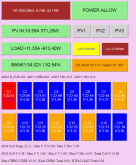cyanogenic
New Member
- Joined
- Oct 14, 2019
- Messages
- 11
Newbie here, following everything from Will's Youtube videos
So my setup:
1. 4x 3.2V 200Ah LiFePo4 cells (from BLS, Aliexpress)
2. ISDT 8S Battery Go balancer
3. 100A Daly BMS with Separate Port
4. Victron battery protect
4. 1500W inverter
My issue:
These 4 cells were balanced to within 5mV at 3.2V when I got them. I've been discharging them slowly via inverter and an LED light. Got them to about 3.1V and then one of the cells would start dipping down a LOT more than the others, e.g. 3.08V, 3.08V, 3.08V, 2.98V.
This cell would continue to drop like a tonne of bricks when discharging further, e.g. 3.0V, 3.0V, 3.0V, 2.75V
These aren't the exact voltages (doing them off memory), but that is the general idea. The cells stay within 20mV of each other from 3.1V - 3.4/3.5V , but when it gets below 3.1V the cells start deviating quite a bit.
I'm trying to do a bottom balance now with them around 3V, but it is taking a LOOONG time due to the difference in voltages.
Could there be an issue with one of these cells?
So my setup:
1. 4x 3.2V 200Ah LiFePo4 cells (from BLS, Aliexpress)
2. ISDT 8S Battery Go balancer
3. 100A Daly BMS with Separate Port
4. Victron battery protect
4. 1500W inverter
My issue:
These 4 cells were balanced to within 5mV at 3.2V when I got them. I've been discharging them slowly via inverter and an LED light. Got them to about 3.1V and then one of the cells would start dipping down a LOT more than the others, e.g. 3.08V, 3.08V, 3.08V, 2.98V.
This cell would continue to drop like a tonne of bricks when discharging further, e.g. 3.0V, 3.0V, 3.0V, 2.75V
These aren't the exact voltages (doing them off memory), but that is the general idea. The cells stay within 20mV of each other from 3.1V - 3.4/3.5V , but when it gets below 3.1V the cells start deviating quite a bit.
I'm trying to do a bottom balance now with them around 3V, but it is taking a LOOONG time due to the difference in voltages.
Could there be an issue with one of these cells?







